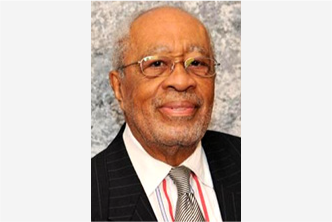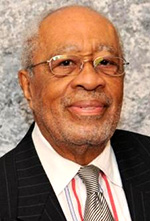
Book Review
by Calvin H. Sinnette, M.D.
(June 2014)
HARLEM’S RATTLERS AND
THE GREAT WAR
By Jeffrey T. Sammons
& John H. Morrow, Jr.
One of my fond childhood memories is the enormous sense of pride and gratification I received from standing on a Harlem street corner as the gleaming steel-helmeted men of the 369th Regiment paraded up Seventh Avenue at the end of their annual two-week summer encampment in upstate New York. Some of the men were neighbors, others were relatives of playmates, all were my heroes and I felt privileged to pay homage to them. Decades later those memories were rekindled as I made my way through the pages of Harlem’s Rattlers and the Great War.
In some quarters the 369th Regiment is referred to as the “Harlem Hellfighters.” The authors take exception to that designation and contend that is a nickname probably conjured up as myth and popularized by opportunistic members of the American press corps. In support of their position, the authors cite a regimental scroll presented in 1939 to the commanding officer, then Colonel Benjamin O. Davis, that shows a rattlesnake on the masthead. The authors feel obliged to adhere to the designation the men of the regiment gave to themselves. That the matter is brought to the readers’ attention on the second page of the introductory chapter is an indication of the passion aroused by the issue both within and outside of the regiment.
Eminently qualified as tenured faculty members in the history departments of their respective institutions, professors Jeffrey T. Sammons and John H. Morrow Jr. bring to life the bravery and unstinting loyalty of African American soldiers who fought in the trenches of France during World War I. Simultaneously their painstaking research reveals the extraordinary degree of hypocrisy, slander, and duplicity employed by civilian and military officials to thwart the aspirations of African Americans in their quest for full citizenship rights. As the authors state,” These men did not fight the war to make the world safe for democracy, they fought to convince America to live up to its democratic promise.” And it was an epic struggle that had its origins in the early days of the nation’s history and continued until 1948 when President Harry Truman signed the Executive Order banning racial segregation in the nation’s armed forces.
In the book’s lively twenty-one page introduction, the authors set the stage enabling readers to prepare for the events described in later chapters. An engrossing feature of this section is its treatment of the 1943 musical film Stormy Weather and, to a lesser extent, the 1992 book Jazz by Nobel Prize winning author Toni Morrison. The 369th played a role in each of these creative works that, even if known, is generally underappreciated. As the section draws to a close, a four part rationale for the study is presented. In contrast to much that has been written about military history, often the important role of women is overlooked. Refusing to commit the same error, the authors take pains to point out that women were active participants in the regiment’s struggles.
Wisely choosing to make optimal use of their individual and collective assets, the authors collected and analyzed vast amounts of material housed in repositories and archives in the United States and France. As a result of the exhaustive research, the reader learns about the unrelenting pressure applied by New York City’s black leaders on the recalcitrant white power structure in the city, state, and federal government to establish an all-black combat unit. Finally, on June 3, 1913, after years of delay and broken promises, legislation was signed authorizing New York City “to organize and equip a colored regiment of infantry…” But those who thought victory was in sight would be sadly disappointed. Designated the 15th New York National Guard Regiment, the new unit would encounter repeated setbacks over the next three decades.
In April 1916, Congress declared war on Germany and the regiment intensified its recruitment and training programs to prepare for overseas deployment. After a series of misadventures resulting from incompetence and aggravated by racial bigotry, on January 1, 1918, New York City’s African American military unit, soon to be renamed the 369th, arrives in France. There, serving with the French army in the slaughterhouse of trench warfare and under relentless fire and gas attacks, the regiment achieved its memorable successes. The unit served longer (191 days) in action than any other regiment in the U.S. army, its regimental colors were decorated by the French army for gallantry in action, and two of its privates received the Croix de Guerre for heroism under enemy fire.
In what might be considered as the centerpiece of the book, three chapters are devoted to the battlefield exploits and subsequent careers of the two men, Henry Johnson and Neadhom Roberts. Though later versions sensationalized the events, it was verified that both were on guard duty when their position came under attack by a strong enemy patrol. With grenades and rifle fire they engaged their opponents and were wounded in the early stages of the encounter. When Johnson saw the Germans attempting to capture and remove Roberts from the scene, he leaped into action. Despite his wounds, he used his bolo knife in hand-to-hand combat to kill four of the attackers and forced the remaining members of the patrol to withdraw. For their valor both men were awarded the Croix de Guerre.
The story of Johnson and Roberts may be viewed as a metaphor for the history of their regiment. Despite manifestations of loyalty, perseverance, and a fleeting moment of fame, both the men and the regiment were victims of racial prejudice, indifferent leadership, selfish ambition, betrayal, poor judgment, and an inability or unwillingness to face troubling realities. In the end, both failed to withstand the demands of changing times and succumbed to nostalgia for the past.
It may be regarded as nitpicking, but there is an area the book does not cover adequately. More than once the authors make passing reference to the roles of the 10th U.S. Cavalry and 25th U.S. Infantry Regiments in American military history. Both were important forerunners of the 369th. In their efforts to establish to all-black 369th, did any of the advocates question the complicity of the 10th and 25th in the genocidal wars against Native Americans or the aggression against the Cuban and Filipino peoples in their independence struggles? Or did they, for fear of being labeled as being disloyal, refuse to address the issue? Did the advocates see any contradictions in despised African American soldiers being used to stifle the aspirations of other freedom-loving people, and what were the arguments advanced to reconcile those contradictions? Perhaps the authors are saving the answers for their next book.
From a literary viewpoint, Harlem’s Rattlers is a masterpiece of scholarly research. It is copiously footnoted, has an extensive bibliography, contains many fine photographs, and is tightly edited. It is a thick book (over 600 pages) that, although dense with facts, is a pleasurable read. Even if it is not a volume for a speed reader, one should not be intimidated by its size. Despite the best efforts of the authors, there are sections that pose challenges for the person unfamiliar with obscure military jargon. Like a vintage wine, Harlem’s Rattlers is a reading experience to be savored.
* * * *
Dr. Calvin Sinnette of Arlington, Va., has conducted extensive research on the history of the African American golf experience. After 15 years of writing and research, Sinnette published his book, Forbidden Fairways: African Americans and the Game of Golf (June 1998). The book takes an in-depth look at the histories, and stories, of some of the pioneering African American athletes who attempted to break the barriers surrounding the game of golf. Descriptive and intuitive, “Forbidden Fairways” gives a voice to the passion and perseverance of the talented golfers who struggled to play the game and lets you in on the real story.
Sinnette is a native of New York City’s Harlem, an avid golfer, and a graduate of Howard University’s College of Medicine. In 2011 he was inducted into the National Black Golf Hall of Fame (Atlanta, Ga.) He was introduced to golf while serving as a United States Air Force medical officer in Southern Germany. In 1998, following five years of research, his book was published. That same year he petitioned the Professional Golfers Association of America (PGA) to award posthumous membership to William “Bill” Spiller who, fifty years earlier, had applied for, but was denied, membership. Joined by others, Dr. Sinnette’s advocacy was instrumental in persuading the PGA to reverse the 1948 decision that stemmed from the organization’s exclusionary racial policy. In November 2009 the PGA awarded posthumous membership to Spiller, Theodore “Ted” Rhodes, and John Shippen. On that occasion it also awarded Honorary Membership to former world heavyweight boxing champion, Joe Louis.





